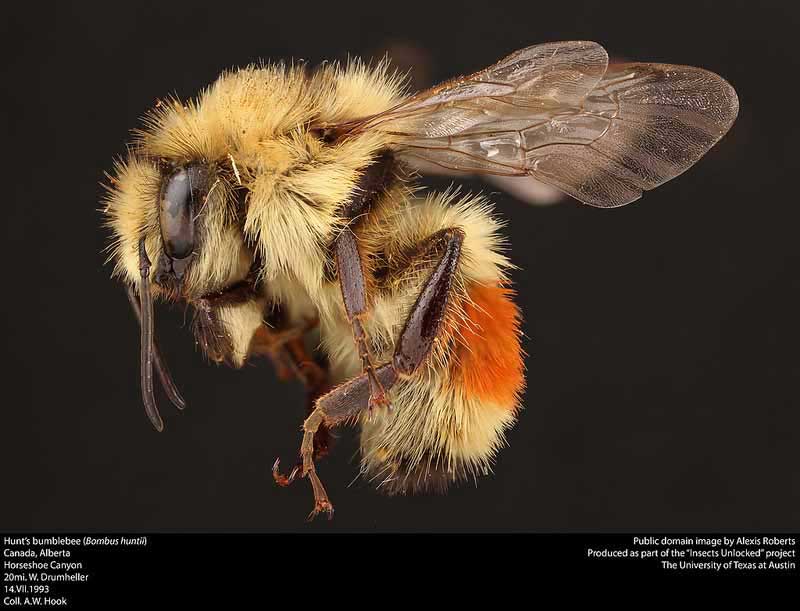
Superregnum: Eukaryota
Cladus: Unikonta
Cladus: Opisthokonta
Cladus: Holozoa
Regnum: Animalia
Subregnum: Eumetazoa
Cladus: Bilateria
Cladus: Nephrozoa
Cladus: Protostomia
Cladus: Ecdysozoa
Cladus: Panarthropoda
Phylum: Arthropoda
Subphylum: Hexapoda
Classis: Insecta
Cladus: Dicondylia
Subclassis: Pterygota
Cladus: Metapterygota
Infraclassis: Neoptera
Cladus: Eumetabola
Cladus: Endopterygota
Superordo: Hymenopterida
Ordo: Hymenoptera
Subordo: Apocrita
Superfamilia: Apoidea
Familia: Apidae
Subfamilia: Apinae
Tribus: Bombini
Genus: Bombus
Subgenus: Thoracobombus
Species: Bombus huntii
Name
Bombus huntii Greene, 1860
References
Bombus (Pyrobombus) at Natural History Museum.
Bombus huntii is a species of bumblebee. It is native to western North America, where it occurs in western Canada and the United States as far east as Manitoba and Minnesota, and in Mexico as far south as the Trans-Mexican Volcanic Belt.[1] It is known commonly as the Hunt bumblebee[1] or Hunt's bumblebee.[2]
This bee lives in desert scrub, prairies, and meadows. In the southern part of its range in Mexico it lives in pine ecosystems and it can be found at high elevations, such as the tops of tall volcanoes. The bee is active in summer and fall, and in southern areas it flies throughout much of the year. It nests underground.[1]
Food plants visited by this species include rabbitbrush, thistles, sunflowers, penstemons, phacelias, currants, rudbeckias, and clovers.[1]
This species has experienced declines, but it is still one of the more common bees of western North America.[1]
This bumblebee is susceptible to certain viruses that infect honey bees, such as Black Queen Cell Virus (BQCV)[3] and Deformed Wing Virus (DWV).[4]
Experiments suggest that this and other native species make efficient pollinators of crop plants such as tomatoes, and that commercial rearing would be a viable alternative to introducing non-native bees for the purpose.[5]
References
Wikimedia Commons has media related to Bombus huntii.
Hatfield, R., et al. 2015. Bombus huntii. This bee has also been seen in Vermont as of May 3, 2020. The IUCN Red List of Threatened Species. Downloaded on 07 March 2016.
NatureServe. 2015. Bombus huntii. NatureServe Explorer Version 7.1. Accessed 7 March 2016.
Peng, W., et al. (2011). Host range expansion of honey bee Black Queen Cell Virus in the bumble bee, Bombus huntii. Apidologie, 42, 650-658.
Li, J., et al. (2011). Cross-species infection of deformed wing virus poses a new threat to pollinator conservation. Archived 2016-03-08 at the Wayback Machine Journal of Economic Entomology, 104(3), 732-739.
Strange, J. P. (2015). Bombus huntii, Bombus impatiens, and Bombus vosnesenskii (Hymenoptera: Apidae) pollinate greenhouse-grown tomatoes in western North America. Journal of Economic Entomology, 108(3), 873-879.
Further reading
Gardner, K. E., Foster, R. L., & O’Donnell, S. (2007). Experimental analysis of worker division of labor in bumblebee nest thermoregulation (Bombus huntii, Hymenoptera: Apidae). Behavioral Ecology and Sociobiology, 61(5), 783–792.
Xu, J., et al. (2013). Detoxification and stress response genes expressed in a western North American bumble bee, Bombus huntii (Hymenoptera: Apidae). BMC Genomics, 14(1), 1.
Retrieved from "http://en.wikipedia.org/"
All text is available under the terms of the GNU Free Documentation License

